 06-28-2016, 01:38 PM
06-28-2016, 01:38 PM
|
#131 (permalink)
|
|
EcoModding Lurker
Join Date: May 2016
Location: Northern California
Posts: 23
Thanks: 1
Thanked 10 Times in 9 Posts
|
Since skirts were banned, F1 has been using vortices to separate high and low pressure areas at the edge of the floorpan. I really want to believe mercedes and audi are that clever, but can't seem to find a vortex generator in that style online
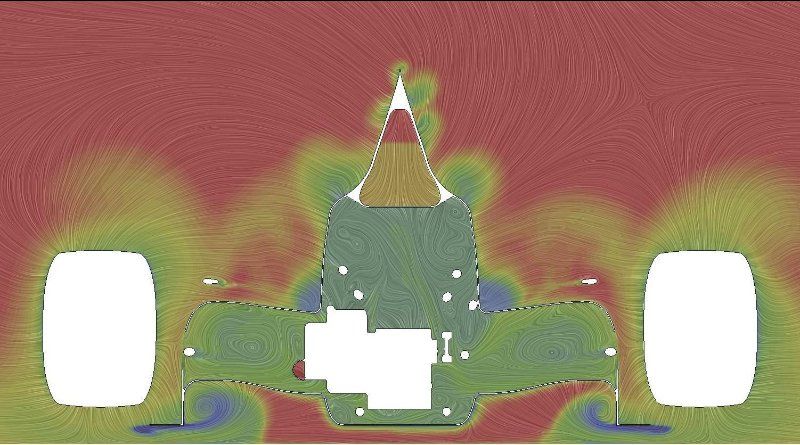
While the dimples seem to be a dead end, vortices under the car aren't. Sealing the floor of the car without killing ground clearance is huge for a street car and should improve the efficiency of the undertray if you didn't go too overboard
I would go for something along what ferrari did with the 488 because it's simple to make. 6 is overboard and performance minded, but one for each side could be used to fence the skirt area and duct some of the engine bay air
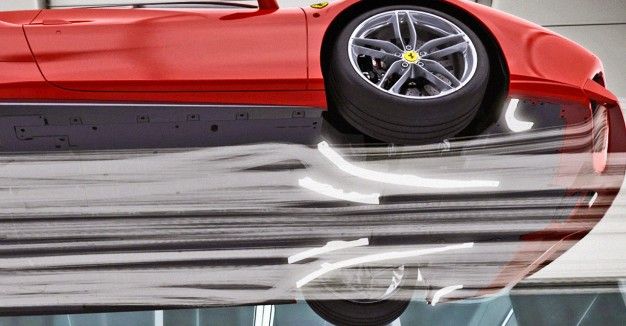 How the Ferrari 488GTB Makes the Air Its Ally
How the Ferrari 488GTB Makes the Air Its Ally
|
|
|

|
|
The Following User Says Thank You to Pooft Lee For This Useful Post:
|
|
 Today Today
|
|
|
|
 Other popular topics in this forum...
Other popular topics in this forum...
|
|
|
|
 06-28-2016, 03:42 PM
06-28-2016, 03:42 PM
|
#132 (permalink)
|
|
Master EcoModder
Join Date: Aug 2012
Location: northwest of normal
Posts: 29,459
Thanks: 8,384
Thanked 9,141 Times in 7,547 Posts
|
Quote:

We're told it's "optimized" but don't get to hear why
|
Well they show you why, it's in the colors. Green is ambient (either pressure or velocity). Red is getting ' mangled' by body below the stagnation point. Blue is the low pressure created by the receding after-body.
Looking at the design itself, they've placed Air-Tab™ type vortex generators at the sills oriented in the cross-wind direction. I'm not sure if they act on the upwind or leeward side.
Then you have strakes. I haven't seen much on them but they appear here, third from the top left:
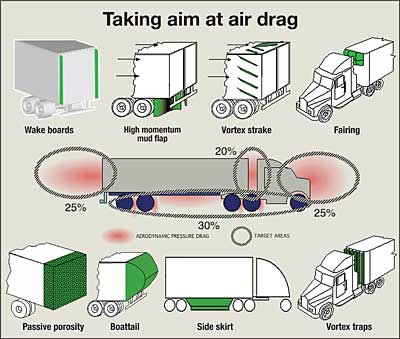
Mercedes seem to use them to moderate the red [pressure/velocity] on the sides but let a plume through down the center that results in an ambient condition at the center bottom of the wake.
Notice that in the wake the blue lines are evenly spaced, but in the green area they are bunched up.
Crafty. The Ferrari solution doesn't look like it would do much. Compare to this:
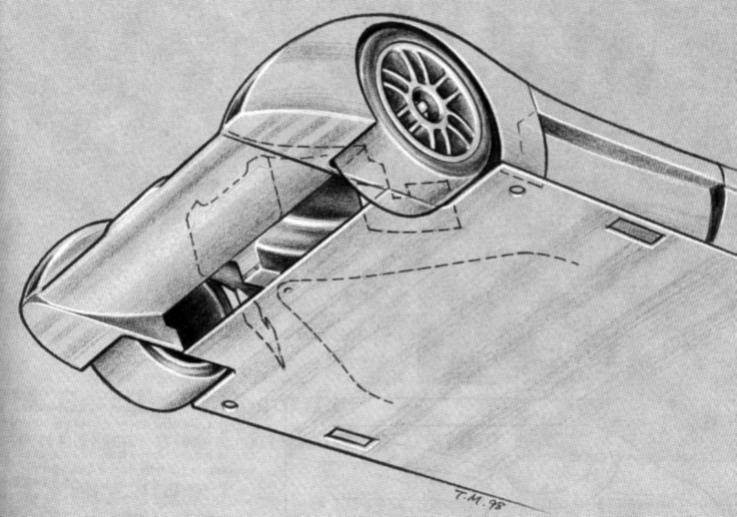
Edit: I looked at the Ferrari article. There are two new examples of Ferrari using external ducts on the rear. 
Last edited by freebeard; 06-28-2016 at 03:51 PM..
|
|
|

|
 06-28-2016, 05:27 PM
06-28-2016, 05:27 PM
|
#133 (permalink)
|
|
EcoModding Lurker
Join Date: May 2016
Location: Northern California
Posts: 23
Thanks: 1
Thanked 10 Times in 9 Posts
|
Edit: sorry for all the picture quotes! I'll come back and pull them
Quote:
Originally Posted by freebeard

Well they show you why, it's in the colors. Green is ambient (either pressure or velocity). Red is getting ' mangled' by body below the stagnation point. Blue is the low pressure created by the receding after-body.
Looking at the design itself, they've placed Air-Tab™ type vortex generators at the sills oriented in the cross-wind direction. I'm not sure if they act on the upwind or leeward side.
Then you have strakes. I haven't seen much on them
Mercedes seem to use them to moderate the red [pressure/velocity] on the sides but let a plume through down the center that results in an ambient condition at the center bottom of the wake.
Notice that in the wake the blue lines are evenly spaced, but in the green area they are bunched up.
Crafty. The Ferrari solution doesn't look like it would do much. Compare to this:

Edit: I looked at the Ferrari article. There are two new examples of Ferrari using external ducts on the rear.  |
Cross wind aerodynamics is one thing I have zero understanding of, but would like to delve into. It is interesting they would have a higher pressure in the center than the flanks of the floorpan.
Ferrari seems to be doing the opposite with their strakes. I like the strake because it's simple. Even if vortices are weak, they're diverting air away from the center and towards the outside of the floorpan, making the center the lowest pressure region of the pan and if the strakes work as intended, keeping flow moving with vortices
I LOVE their rear wing design. Its very well integrated and elegant
Last edited by Pooft Lee; 06-30-2016 at 02:35 PM..
|
|
|

|
 06-28-2016, 06:48 PM
06-28-2016, 06:48 PM
|
#134 (permalink)
|
|
Master EcoModder
Join Date: Aug 2012
Location: northwest of normal
Posts: 29,459
Thanks: 8,384
Thanked 9,141 Times in 7,547 Posts
|
Quote:
|
Cross wind aerodynamics is one thing I have zero understanding of, but would like to delve into.
|
At small angles: Morelli's Banana car. At high angles: NASCAR rooftop fences to spoil lift when driving sideways.
Quote:
|
It is interesting they would have a higher pressure in the center than the flanks of the floorpan.
|
Consider the Aerocivic; it goes to great pains to contain and segregate wheelwell turbulence and underbody airflow.
Quote:
|
Ferrari seems to be doing the opposite with their strakes... Even if vortices are weak, they're diverting air away from the center and towards the outside of the floorpan, making the center the lowest pressure region...
|
Once again, I don't get strakes, but I compare to the driprail on the roof of my Superbeetle. I think the strake at 45° angle will (like a Gurney flap) roll the air toward the center of the car, not deflect it outward.
If it operates as you describe, the rearmost strake ends way early. |
|
|

|
 06-28-2016, 11:20 PM
06-28-2016, 11:20 PM
|
#135 (permalink)
|
|
EcoModding Lurker
Join Date: May 2016
Location: Northern California
Posts: 23
Thanks: 1
Thanked 10 Times in 9 Posts
|
Quote:
Originally Posted by freebeard

At small angles: Morelli's Banana car. At high angles: NASCAR rooftop fences to spoil lift when driving sideways.
|
I did find a CFD animation of an f1 car changing angles (for a turn) that's pretty cool. You can see pressure zones walking around and changing magnitude
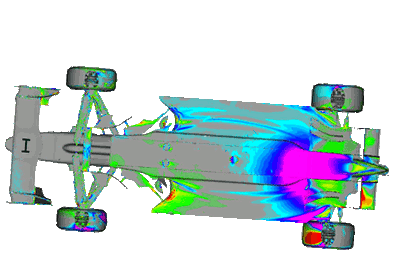
Quote:
Originally Posted by freebeard

Consider the Aerocivic; it goes to great pains to contain and segregate wheelwell turbulence and underbody airflow.
|
I understand keeping them separate, but I was surprised the center had the slowest and highest pressure of the floorpan. The openings for exhaust probably hamstrung their efforts a little. But it makes sense do try and raise pressure at the wake
Quote:
Originally Posted by freebeard

Once again, I don't get strakes, but I compare to the driprail on the roof of my Superbeetle. I think the strake at 45° angle will (like a Gurney flap) roll the air toward the center of the car, not deflect it outward.
|
I saw an interesting picture earlier that I'll post when I get home, but it should work like fin style vortex generators while guiding some airflow as well
Quote:
Originally Posted by freebeard

If it operates as you describe, the rearmost strake ends way early.
|
I think they're juggling moving away from center, and having several vortices that drive airflow across the full width of the pan. Strakes further rear end further inboard so they have vortices in more than one place along the pan. A vortex can provide more force than laminar flow, at the expense of drag. The fins on rear diffusers are vortex generators. For anyone interested here's a great presentation I found on it from an F1 engineer. Its pretty cool stuff. This guy knows a lot and isn't afraid to share it
https://www.linkedin.com/pulse/how-d...rk-willem-toet
|
|
|

|
 06-28-2016, 11:51 PM
06-28-2016, 11:51 PM
|
#136 (permalink)
|
|
EcoModding Lurker
Join Date: May 2016
Location: Northern California
Posts: 23
Thanks: 1
Thanked 10 Times in 9 Posts
|
Had a bit of a eureka moment; this:

Is showing a vortex created by this:
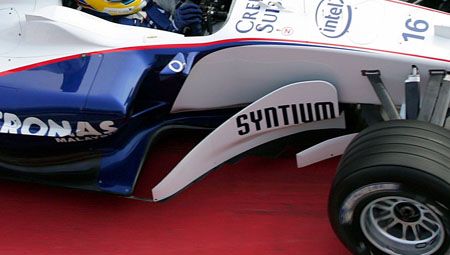
F1s barge boards have some key differences to the strakes, namely the sloping face, but air hits the face, some spills over the edge into the low pressure, and the rest is pushed along towards the end, creating a vortex directed outwards. I think Ferrari's are much milder, and don't spit out a tengent vortex, but the idea seems to make sense to me. I'm thinking it's working along the same lines as a slat style vortex generator, like those found on aircraft wings. The American society of Mechanical engineers has a research paper on exactly what ferrari is doing, I'm going to see if it lets me access it or if I need to register
Aerodynamics of Large-Scale Vortex Generator in Ground Effect | Journal of Fluids Engineering | ASME DC
If I can figure out my student license with AutoDesk's CFD I'll test out a model of the curved strake and post here |
|
|

|
|
The Following User Says Thank You to Pooft Lee For This Useful Post:
|
|
 06-29-2016, 03:41 PM
06-29-2016, 03:41 PM
|
#137 (permalink)
|
|
Master EcoModder
Join Date: Jan 2008
Location: Sanger,Texas,U.S.A.
Posts: 16,548
Thanks: 24,522
Thanked 7,442 Times in 4,822 Posts
|
Reynolds number
Quote:
Originally Posted by Pooft Lee

Do you know a good place to read on the reynolds numbers? My knowledge with aero so far is pretty existential. There's a lot of guessing by feel and checking the results if you don't have CFD and don't know the math. I thought the boundary layer would thicken and continue to drag along a surface until it had to contend with a change in direction. Is the the turbulence you're talking about from the boundary layer slowing to a crawl and falling apart?
As far as the bandaid thing, a lot of engineering is bandaids but I see where you're going with elegant design. An afterthought shouldn't be praised as a breakthrough. I was referring to the Audi photos posted earlier with significant dimples 2-4" across that have a clear defined shape. I haven't posted enough here quite yet to link the photos, I believe they were page 1. But they seem concentrated around boundaries. It looks like the interest is around the edges of the floorpan, and the gap for the exhaust and transmission.
In an application where you can't be scraping every speed bump with nice ducting and diffusers, using vortex generators to fence airflow boundaries without impacting ground clearance is pretty elegant engineering. I'd really like to know if that's their real game with those large dimples on the undertray. On a golf ball, dimples trip up the boundary layer to keep it moving, if you created turbulent, faster airflow in the right places it should do a good job dividing different areas so you don't have unwanted spill over different pressure boundaries
|
I'll try a link here for Reynolds number
http://ecomodder.com/forum/showthrea...ion-14818.html
*The boundary layer does thicken,but there's nothing we can do about it.It's a viscosity phenomena,responsible for skin friction.No smoothing of the body can reduce it.
*Turbulence is caused by any perturbation to the flow,either by velocity change,deflection of flow,separation of flow,or introduced vorticity.Hucho warns us not to introduce any 'kinks' along the flow pathway,which would include vortices.
*If you create any kind of turbulence,the kinetic energy of the stream is lost to atmospheric heating.The energy lost can never be recovered as a pressure gain,to raise the base pressure behind the car.Since raising the base pressure is the entire foundation of streamlining,you're committing the greatest sin.
*If you can find a Tesla S,take a look underneath it to see what they've done.It is the lowest drag production car available to us.
*The Cd 0.21 GM EV 1 had a smooth bottom as well.
*None of the racing teams,with the world's lowest drag use anything but extremely smooth bellies.
__________________
Photobucket album: http://s1271.photobucket.com/albums/jj622/aerohead2/
|
|
|

|
|
The Following User Says Thank You to aerohead For This Useful Post:
|
|
 06-30-2016, 02:45 PM
06-30-2016, 02:45 PM
|
#138 (permalink)
|
|
EcoModding Lurker
Join Date: May 2016
Location: Northern California
Posts: 23
Thanks: 1
Thanked 10 Times in 9 Posts
|
Quote:
Originally Posted by freebeard

Crafty. The Ferrari solution doesn't look like it would do much. Compare to this:

Edit: I looked at the Ferrari article. There are two new examples of Ferrari using external ducts on the rear.  |
This went right over my head, woops. think ducting is a good solution, but only when integrated into the design. It would be difficult to add underneath a car that wasn't designed with it in mind, like most projects on here. Its doable, but building down would kill your ground clearance, and building up would require cutting floorpan. I do intend to do ducting to my radiator and out the hood, but cutting holes is a big commitment. I might try and nudge airflow out behind the front wheels so it doesn't hang around the engine bay and pass under the car. I might buy some of the famous garden ending after work and get creative. But testing it will take patience
|
|
|

|
 06-30-2016, 02:53 PM
06-30-2016, 02:53 PM
|
#139 (permalink)
|
|
EcoModding Lurker
Join Date: May 2016
Location: Northern California
Posts: 23
Thanks: 1
Thanked 10 Times in 9 Posts
|
Also, wanted to say a huge thanks is in order for all you guys's wisdom and eagerness to discuss this stuff. Its great to have a community to get into this stuff with. Aerodynamics is one of those subjects I get very excited about. I'm a little ignorant on the subject (next quarter is fluid mechanics  ) but you guys let me jump right in on this stuff, and most importantly learn.
I'll keep things a little more on-topic, but wanted to say I'm very happy I found this forum, and happier still that knowledgeable people like yourselves frequent it.
End rant, and I'll get back to the science  |
|
|

|
 06-30-2016, 07:32 PM
06-30-2016, 07:32 PM
|
#140 (permalink)
|
|
Master EcoModder
Join Date: Aug 2012
Location: northwest of normal
Posts: 29,459
Thanks: 8,384
Thanked 9,141 Times in 7,547 Posts
|
Eh, everyone else just wants to talk about politics or religion or relationships; instead of, you know, the important stuff. 
One of the reasons I like the VW Beetle as a platform is (with the torsion bar models) with a bolt-in part you can move the front axle line forward eight inches. Along with the narrow door hinge line this gives opportunity for the ductwork the Toyota approach requires.
|
|
|

|
|